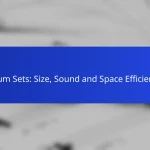Woodwind instruments, such as the clarinet, flute, and saxophone, are excellent choices for beginners due to their ease of learning and versatility across music genres. When selecting an instrument, it’s important to consider the craftsmanship and sound quality offered by various brands, as they cater to different skill levels and personal preferences. Additionally, pricing can vary widely, with entry-level models being more affordable while premium options reflect higher craftsmanship and materials.

Which woodwind instruments are best for beginners?
For beginners, the best woodwind instruments typically include the clarinet, flute, and saxophone. These instruments are known for their relative ease of learning and versatility in various music genres.
Clarinet for ease of learning
The clarinet is often recommended for beginners due to its straightforward fingerings and clear sound. It has a single-reed mouthpiece, which makes it easier to produce sound compared to double-reed instruments.
Students can start playing simple melodies within a few weeks, making it a popular choice in school bands and orchestras. Additionally, the clarinet’s range allows for progression into more complex pieces as skills develop.
Flute for versatility
The flute is a versatile woodwind instrument that suits various musical styles, from classical to pop. Its unique sound and lightweight design make it appealing to many beginners.
Learning the flute involves mastering breath control and finger placement, which can be challenging but rewarding. Beginners can expect to play simple tunes within a month, and the instrument’s portability makes it easy to practice anywhere.
Saxophone for popular music
The saxophone is a fantastic choice for beginners interested in popular music genres like jazz and rock. Its rich, expressive tone and ease of sound production attract many new players.
With a single-reed mouthpiece similar to the clarinet, beginners can quickly learn to play basic notes and rhythms. The saxophone’s popularity in contemporary music means students will find plenty of resources and songs to practice, enhancing their learning experience.

What are the key features of popular woodwind brands?
Popular woodwind brands are known for their craftsmanship, sound quality, and suitability for different skill levels. Each brand offers unique features that cater to musicians, from beginners to professionals, making it essential to choose the right one based on individual needs and preferences.
Yamaha clarinets for quality
Yamaha clarinets are renowned for their exceptional build quality and consistent performance. They often feature durable materials, precise key mechanisms, and a warm, rich tone that appeals to both students and advanced players.
When selecting a Yamaha clarinet, consider models like the YCL-255, which is ideal for beginners due to its affordability and ease of play. For more advanced players, the YCL-650 offers superior sound and craftsmanship, making it a popular choice among professionals.
Selmer saxophones for professional use
Selmer saxophones are a top choice for professional musicians, known for their superior sound projection and tonal richness. These instruments are crafted with high-quality materials and feature ergonomic designs that enhance playability.
Models like the Selmer Mark VI are legendary among saxophonists for their versatility and expressive capabilities. While they can be on the pricier side, investing in a Selmer saxophone often pays off in terms of performance and longevity.
Gemeinhardt flutes for students
Gemeinhardt flutes are specifically designed for student musicians, offering a balance of affordability and quality. These flutes are lightweight and easy to handle, making them suitable for younger players who are just starting their musical journey.
The Gemeinhardt 2SP model is particularly popular among beginners due to its solid construction and clear sound. Additionally, the brand provides various options to accommodate different budgets, ensuring that students can find a suitable instrument without overspending.

How do woodwind instruments compare in pricing?
Woodwind instruments vary significantly in pricing based on their type, brand, and quality. Entry-level models are generally affordable, while premium instruments can be quite expensive, often reflecting their craftsmanship and materials.
Entry-level prices for clarinets
Entry-level clarinets typically range from around $300 to $800. These instruments are designed for beginners and often feature plastic bodies and simpler key mechanisms. Brands like Yamaha and Buffet Crampon offer reliable options in this price range.
When selecting an entry-level clarinet, consider factors such as ease of playability and durability. It’s advisable to try out a few models to find one that feels comfortable and suits your playing style.
Mid-range costs for flutes
Mid-range flutes generally cost between $800 and $2,500. These flutes often feature silver bodies and more advanced key mechanisms, providing better sound quality and playability. Brands like Gemeinhardt and Pearl are popular choices in this category.
Investing in a mid-range flute can significantly enhance a student’s learning experience. Look for features like a closed or open hole design, which can affect sound production and technique development.
Premium saxophone pricing
Premium saxophones can range from $2,500 to over $10,000, depending on the brand and model. High-end saxophones, such as those from Selmer or Yanagisawa, are crafted from superior materials and offer exceptional sound quality and responsiveness.
When considering a premium saxophone, focus on the specific sound characteristics and build quality that suit your musical style. It’s beneficial to test several models to determine which instrument feels and sounds best for you.

What are the compatibility factors for woodwind instruments?
Compatibility factors for woodwind instruments include the type of reeds, headjoint designs, and necessary accessories that influence performance and playability. Understanding these elements helps musicians select the right equipment for their specific woodwind instrument.
Reed compatibility for clarinets
Reed compatibility for clarinets is crucial, as different models require specific reed strengths and materials. Most clarinets use cane reeds, which are available in various strengths typically ranging from 1.5 to 5.0. Beginners often start with softer reeds, while advanced players may prefer harder reeds for greater control and tone quality.
When selecting reeds, consider the brand and cut, as these can affect sound and response. Popular brands like Vandoren and Rico offer various options, so trying different reeds can help find the best match for your clarinet and playing style.
Headjoint options for flutes
Flute headjoint options significantly impact sound quality and playability. Standard headjoints are generally made from silver, but options like gold or platinum can enhance tonal richness. Additionally, different lip plate designs and embouchure cuts can affect how easily a player produces sound.
Players should experiment with various headjoint styles to determine which best suits their playing technique and sound preferences. Custom headjoints are also available, allowing for personalized adjustments that can improve comfort and performance.
Accessory needs for saxophones
Saxophones require specific accessories to enhance playability and maintenance. Essential accessories include neck straps, mouthpieces, and ligatures, which can affect comfort and sound production. Choosing a quality mouthpiece can significantly alter the instrument’s tone and response.
Additionally, maintenance items such as cleaning swabs and pads are vital for keeping the saxophone in optimal condition. Regular care helps prevent issues like leaks and ensures a consistent playing experience. Consider investing in a good-quality case to protect the instrument during transport.

What are the maintenance requirements for woodwind instruments?
Woodwind instruments require regular maintenance to ensure optimal performance and longevity. Key maintenance tasks include cleaning, proper storage, and periodic professional servicing to address wear and tear.
Cleaning techniques for clarinets
To clean a clarinet, start by disassembling the instrument and using a soft cloth to wipe down the exterior. Inside, use a swab to remove moisture from the bore after each use, which helps prevent mold and bacteria growth.
Regularly check the pads for dirt and moisture, as dirty pads can affect sound quality. If necessary, replace them every few years or when they show signs of wear.
Care tips for flutes
Flutes should be cleaned after each playing session. Use a cleaning rod with a soft cloth to remove moisture from the inside of the instrument. Avoid using any abrasive materials that could scratch the surface.
Store the flute in a protective case to prevent damage. Regularly inspect the pads and springs for any signs of wear, as these components may need replacement to maintain proper functionality.
Maintenance for saxophones
Saxophones require both internal and external cleaning. After playing, wipe down the exterior with a soft cloth and use a swab to clean the neck and body to remove moisture. This practice helps to prevent the buildup of grime and corrosion.
Check the pads and corks regularly for wear. Replace pads as needed, typically every few years, and ensure that the corks are properly lubricated to maintain a good seal.

How do woodwind instruments perform in different music genres?
Woodwind instruments exhibit unique characteristics that make them suitable for various music genres, influencing their sound and playability. The choice of instrument can significantly affect the overall feel and expression of the music, particularly in genres like jazz and classical.
Jazz with saxophones
Saxophones are a staple in jazz music, known for their rich, expressive tones and versatility. They can produce a wide range of sounds, from smooth and melodic to sharp and edgy, allowing musicians to convey deep emotions and improvisational flair.
In jazz, saxophonists often utilize techniques such as bending notes and playing with vibrato to enhance their performance. The instrument’s ability to blend with other instruments while standing out during solos makes it a favorite among jazz musicians.
Classical with flutes
Flutes are prominent in classical music, valued for their light, airy sound and agility. They are capable of producing intricate melodies and are often featured in orchestral settings, where their tone can cut through the ensemble beautifully.
When playing classical pieces, flutists focus on breath control and articulation to achieve clarity and precision. The flute’s range allows for both delicate passages and powerful crescendos, making it an essential instrument in many classical compositions.






